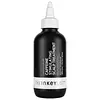The INKEY List Caffeine Stimulating Scalp Treatment Versus The INKEY List Peptide Volumizing Hair Treatment
What's inside
What's inside
 Key Ingredients
Key Ingredients

 Benefits
Benefits

 Ingredients Side-by-side
Ingredients Side-by-side

Water
Skin ConditioningBetaine
HumectantCaffeine
Skin ConditioningPanthenol
Skin ConditioningPhenoxyethanol
PreservativeGlycerin
HumectantXanthan Gum
EmulsifyingEthylhexylglycerin
Skin ConditioningTrisodium Ethylenediamine Disuccinate
Lactic Acid
BufferingSodium Metabisulfite
AntioxidantGlycine
BufferingLarix Europaea Wood Extract
HumectantCamellia Sinensis Extract
AntioxidantZinc Chloride
AntimicrobialWater
Skin ConditioningPisum Sativum Peptide
Skin ConditioningBetaine
HumectantGlycerin
HumectantPanthenol
Skin ConditioningPEG-40 Hydrogenated Castor Oil
EmulsifyingPhenoxyethanol
PreservativePolyquaternium-37
Citronellyl Methylcrotonate
MaskingEthylhexylglycerin
Skin ConditioningCeratonia Siliqua Seed Extract
Skin ConditioningHydrolyzed Soy Protein
HumectantZea Mays Starch
AbsorbentLeuconostoc/Radish Root Ferment Filtrate
AntimicrobialTrisodium Ethylenediamine Disuccinate
Polyquaternium-16
Potassium Sorbate
PreservativeSodium Benzoate
MaskingGuar Hydroxypropyltrimonium Chloride
Skin ConditioningPolyquaternium-7
Water, Pisum Sativum Peptide, Betaine, Glycerin, Panthenol, PEG-40 Hydrogenated Castor Oil, Phenoxyethanol, Polyquaternium-37, Citronellyl Methylcrotonate, Ethylhexylglycerin, Ceratonia Siliqua Seed Extract, Hydrolyzed Soy Protein, Zea Mays Starch, Leuconostoc/Radish Root Ferment Filtrate, Trisodium Ethylenediamine Disuccinate, Polyquaternium-16, Potassium Sorbate, Sodium Benzoate, Guar Hydroxypropyltrimonium Chloride, Polyquaternium-7
Ingredients Explained
These ingredients are found in both products.
Ingredients higher up in an ingredient list are typically present in a larger amount.
Betaine is a common humectant (a substance that promotes retention of moisture). It's known to be gentle on the skin and can help balance hydration.
This ingredient is best for improving hydration and soothing irritated skin. Studies also show it helps even out skin tone.
Fun fact: Betaine is naturally created in the skin and body. The kind found within cosmetic products can be either plant-derived or synthetic.
Another name for betaine is trimethylglycine.
Learn more about BetaineEthylhexylglycerin (we can't pronounce this either) is commonly used as a preservative and skin softener. It is derived from glyceryl.
You might see Ethylhexylglycerin often paired with other preservatives such as phenoxyethanol. Ethylhexylglycerin has been found to increase the effectiveness of these other preservatives.
Glycerin is already naturally found in your skin. It helps moisturize and protect your skin.
A study from 2016 found glycerin to be more effective as a humectant than AHAs and hyaluronic acid.
As a humectant, it helps the skin stay hydrated by pulling moisture to your skin. The low molecular weight of glycerin allows it to pull moisture into the deeper layers of your skin.
Hydrated skin improves your skin barrier; Your skin barrier helps protect against irritants and bacteria.
Glycerin has also been found to have antimicrobial and antiviral properties. Due to these properties, glycerin is often used in wound and burn treatments.
In cosmetics, glycerin is usually derived from plants such as soybean or palm. However, it can also be sourced from animals, such as tallow or animal fat.
This ingredient is organic, colorless, odorless, and non-toxic.
Glycerin is the name for this ingredient in American English. British English uses Glycerol/Glycerine.
Learn more about GlycerinPanthenol is a common ingredient that helps hydrate and soothe the skin. It is found naturally in our skin and hair.
There are two forms of panthenol: D and L.
D-panthenol is also known as dexpanthenol. Most cosmetics use dexpanthenol or a mixture of D and L-panthenol.
Panthenol is famous due to its ability to go deeper into the skin's layers. Using this ingredient has numerous pros (and no cons):
Like hyaluronic acid, panthenol is a humectant. Humectants are able to bind and hold large amounts of water to keep skin hydrated.
This ingredient works well for wound healing. It works by increasing tissue in the wound and helps close open wounds.
Once oxidized, panthenol converts to pantothenic acid. Panthothenic acid is found in all living cells.
This ingredient is also referred to as pro-vitamin B5.
Learn more about PanthenolPhenoxyethanol is a preservative that has germicide, antimicrobial, and aromatic properties. Studies show that phenoxyethanol can prevent microbial growth. By itself, it has a scent that is similar to that of a rose.
It's often used in formulations along with Caprylyl Glycol to preserve the shelf life of products.
Trisodium Ethylenediamine Disuccinate is used to help stabilize a product.
It is a chelating agent, meaning it helps prevent metal ions from binding to other ingredients. This prevents unwanted reactions in products. Metal ions can come into a product via the water ingredient. They are found in trace amounts and are not known to be harmful.
Water. It's the most common cosmetic ingredient of all. You'll usually see it at the top of ingredient lists, meaning that it makes up the largest part of the product.
So why is it so popular? Water most often acts as a solvent - this means that it helps dissolve other ingredients into the formulation.
You'll also recognize water as that liquid we all need to stay alive. If you see this, drink a glass of water. Stay hydrated!
Learn more about Water